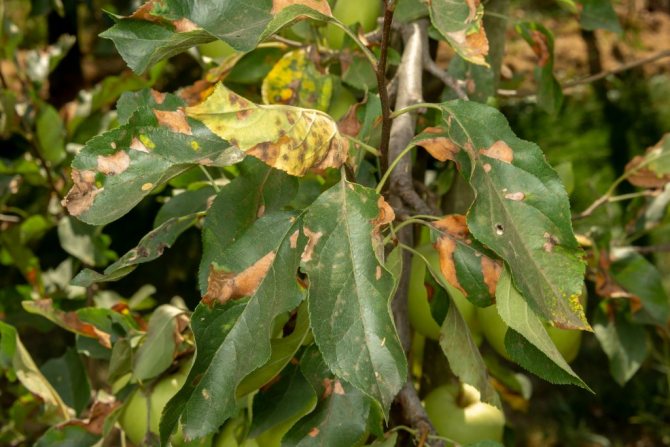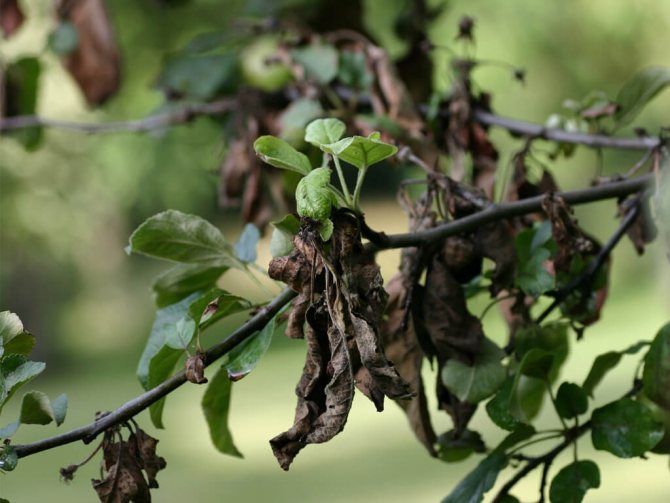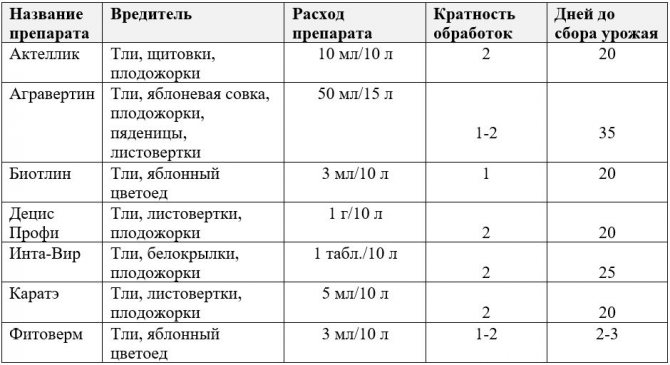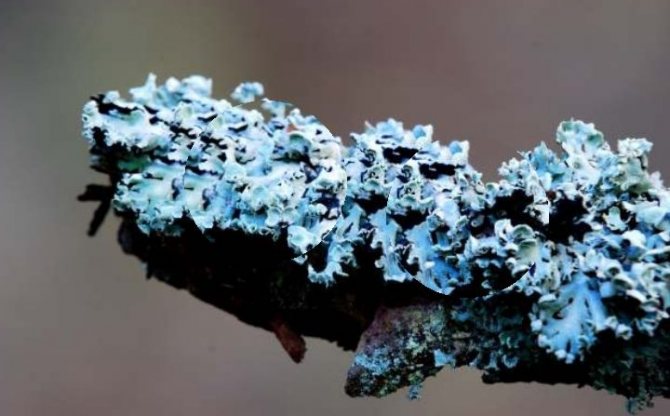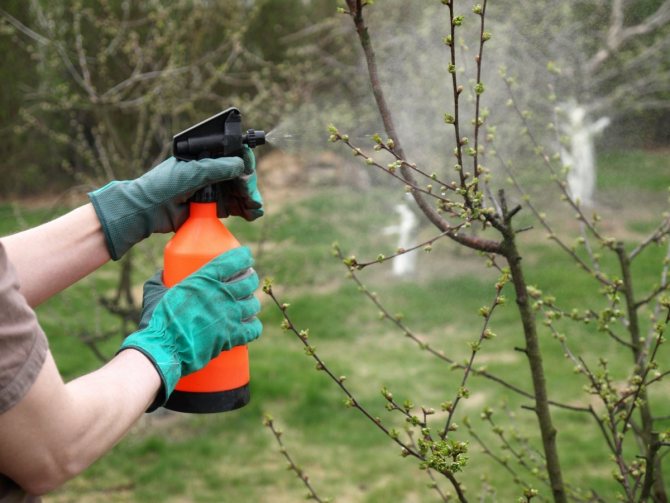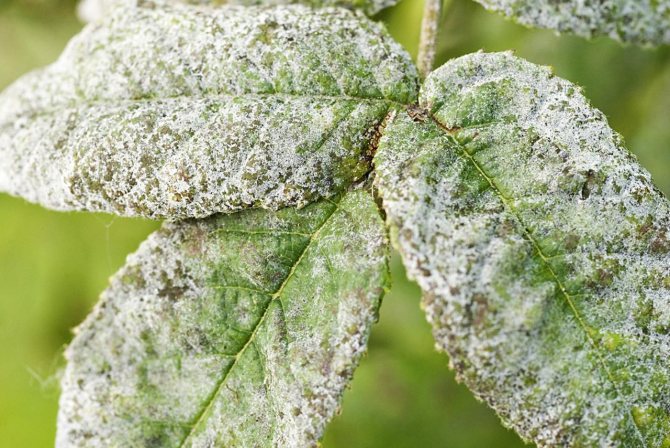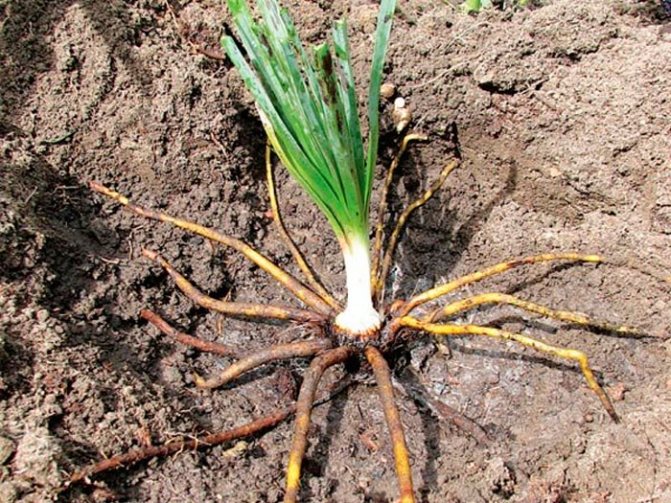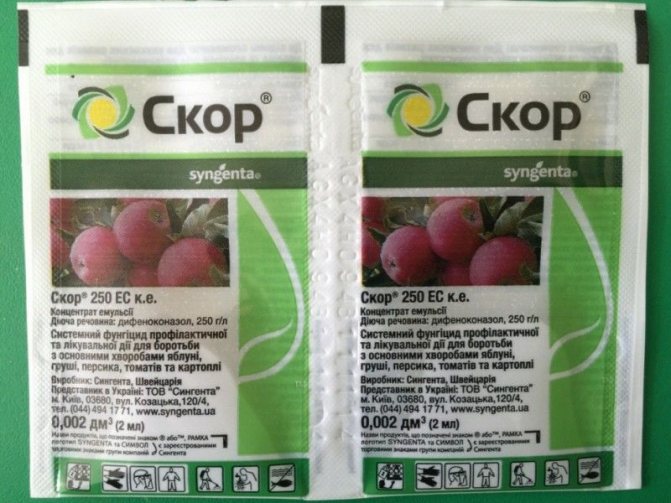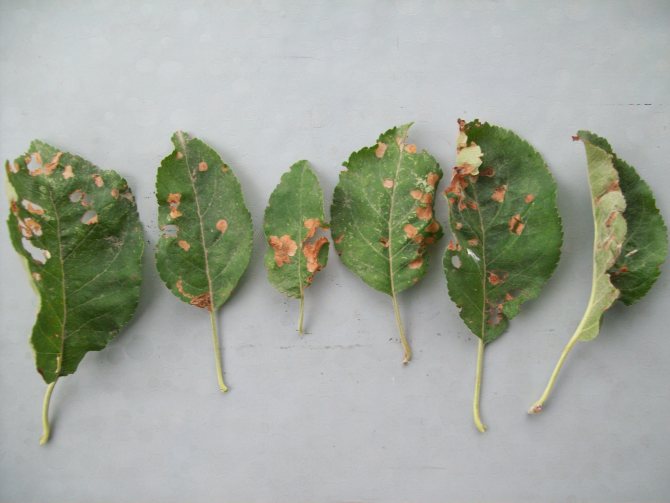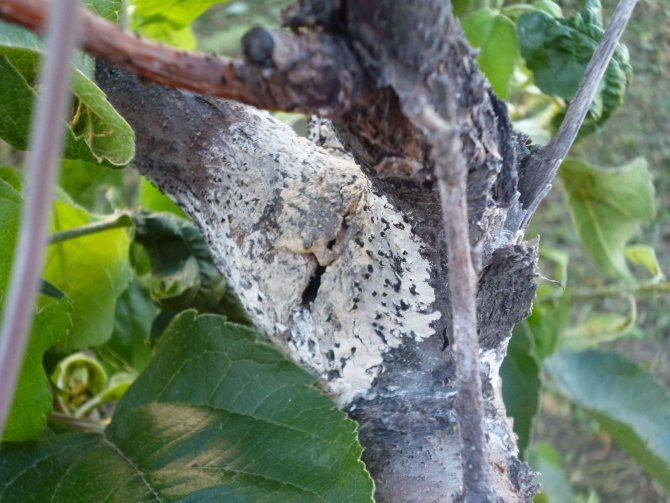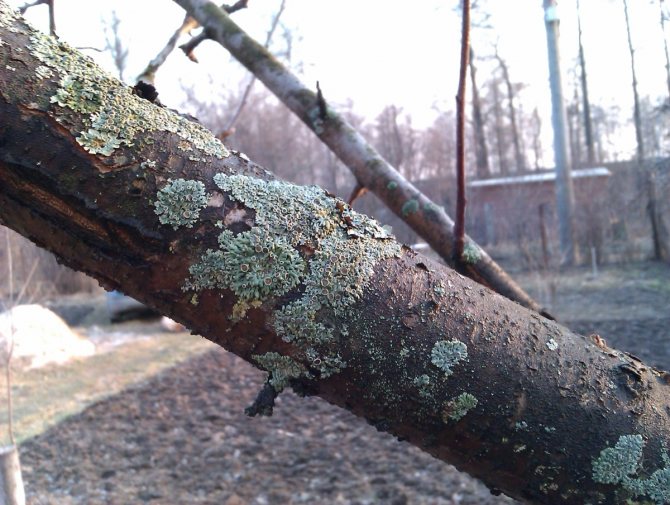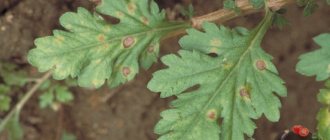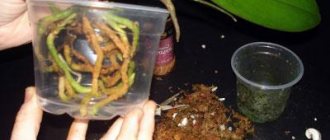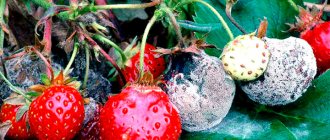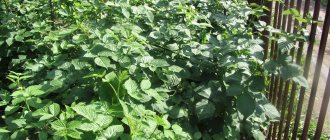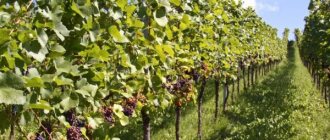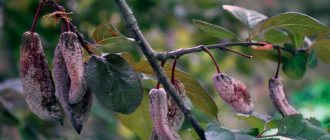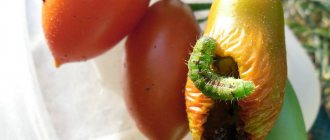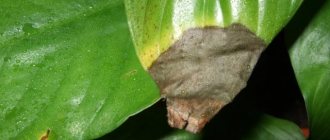Gardening »Apple tree
0
443
Article rating
The fungus on the apple tree retains its vital activity for a long time and is able to activate when conditions favorable for it appear. With the appearance of a fungus in a garden culture, the immunity to diseases decreases and, as a result, the yield level becomes lower, and sometimes this leads to the death of trees.
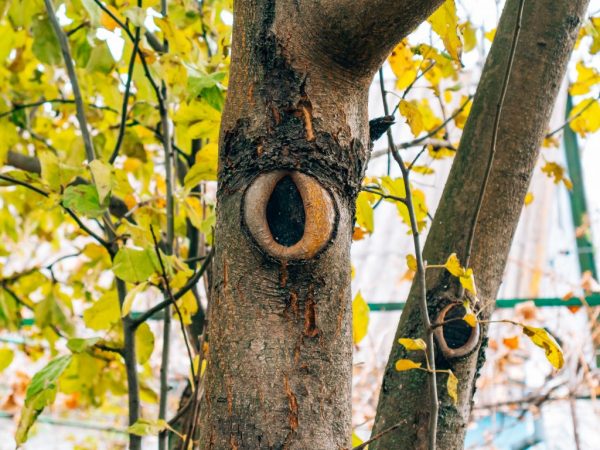
Fighting fungus on an apple tree
The nature of the wound
Non-infectious
Rapid reaction to the occurrence of wounds caused by mechanical damage, will make it impossible to weaken the tree and will save him from infection with various infections... TO mechanical damagethat can injure an apple tree include:
- Pruning;
- Graft;
- Sunburn;
- Frostbreakers;
- The influence of strong winds;
- Bark pest actions;
- Damage by small rodents and birds;
- Fruit overload;
- Excess / lack of moisture;
- Excess / lack of nutrients.
- Apple tree wounds when pruning and grafting, it is not necessary to recognize, because the gardener applies them deliberately. Branches broken off by the wind or heavy fruit are also immediately noticeable. With proper processing of the cuts, the apple tree easily tolerates such interventions without consequences;
- If a bark peels off in large chunks on an apple tree - these are the consequences of a sharp temperature drop or sunburn. These wounds can be identified by their color. It is pink, as if the wood had been scalded with boiling water. To prevent sunburn of the apple tree, you should treat tree trunks with clay or garden whitewashing in the fall;
- Apple tree bark, disheveled and peeled off in stripes at the bottom trunk - the work of rodents;
- Small through holes - the first sign of damage to the apple tree by pests leading a hidden lifestyle, such as:
- Woody wood is corrosive;
- Apple glass bowl;
- Eastern moth;
- An odorous woodworm.
If you open such a move, you can find inside the apple tree cavity, sometimes quite significant. Late detection of wood pests leads to the formation hollow in trunks and large branches;
- If in spring the bark on an apple tree bursts and begins to peel off, do not rush to heal the tree. In mature trees, renewal of the outer layer of the trunk, then a new, young one will be visible under the old bark.
- A sign that the bark is on the apple tree cracks due to difference in growth rates the inner and outer layers is the location of the cracks - they run along the trunk and skeletal branches. A strong, healthy tree will cope with this process by itself and will recover by the next season;
- Apple trees 8 - 10 years old, to reduce the possibility of infection in the tissues, do furrow... In this procedure, the old bark is deliberately cut along the trunk and large branches at intervals of 10-15 cm at the base. The cuts are covered with garden varnish or Ranet paste. In autumn feed the apple tree with fertilizersthat will promote the maturation of the wood. Preparations based on potassium and phosphorus are suitable.
- An apple tree was found in the winter garden, the bark of which was destroyed in a circle by hares;
- Immediately we prevent the apple tree from drying out - we put putty or (in severe frost) oil paint on the damaged area, wrap it in burlap and leave it until spring;
- We cut the cuttings for the scion;
- With the beginning of sap flow with an interval of 3 cm, we graft the bridges in a slightly arcuate manner, carefully applying a scion with necessarily removed buds to match the cambium;
- If the cuttings do not all take root, the next year you can repeat the procedure to improve the nutrition of the apple tree.
- Cytosporosis is a severe fungal disease that often leads to the death of a tree. It is difficult to treat and very easily transmitted. They get sick with cytosporosis (the bark can crack, lag behind, burst, crack, come off, crack / crack, fall off, peel off, exfoliate, fall off, fall off or peel off, cracking) weakened apple trees. The best method of preventing disease is feeding and timely pruning in the spring.
- It is very important that all cuts, both after pruning and in case of branch breakage, as well as cracks (what could crack, bare, peel off, began to peel off and peel off) in the bark or hollow, clean and process with a solution of copper sulfate and cover up (heal, cover ) garden pitch.
- To prevent disease, apple trees are treated with a solution of copper sulfate, colloidal sulfur or fungicidal preparations, like "Hom" three times a season.
- Treatment of cytosporosis involves the removal of infected parts - bark, branches, and chemical treatment - fungicides. However, plants are amenable to treatment only in the initial stages of the disease.
- If an ailment is detected, it is necessary not only to try to save (provide assistance and preserve, cure a sick apple tree) infected trees, but also take all measures to prevent the spread of the fungus.
- Remove all dry branches damaged by diseases, broken ones and those that grow inside the crown.
- To prevent the development of fungal diseases, it is advisable to treat the cut site with diluted copper sulfate, taking a teaspoon of it per liter of water.
- After the cut dries up, it is carefully covered with garden pitch.
- Spread a cloth or paper under the tree, then it should be burned along with the larvae and eggs of pests that have fallen on it.
- Mosses and lichens can be carefully scraped off with a plastic or wooden tool. It will be easier to do this if you first cover it with a mixture of slaked lime and clay, diluted with water to the consistency of thick sour cream.
- After the mixture dries, the moss is removed more easily, and the bark is less damaged. Damaged bark is covered with garden var.
- Cytosporosis leads to the drying out of the tree, the apple tree, in the struggle for life, simply drops the harvest;
- On defeat powdery mildew ovaries crumble without developing;
- Black cancer generally destroys the tree.
- treat wounds with garden pitch;
- monitor the moisture content of the soil, it should not be constantly wet;
- thin out the crown in time;
- fight pests;
- treat the plant from fungi and insects.
Read more about the causes of bark peeling here.
Restoring the bark on an apple tree
To restore the lost areas of the bark, you should clean off any dead tissue. Particular attention should be paid to cleaning deep cavities formed by insects.In the depths of the hollows, a large amount of pest debris accumulates. Open area disinfected any copper-containing preparation, most often a 1% solution of copper sulfate is used.
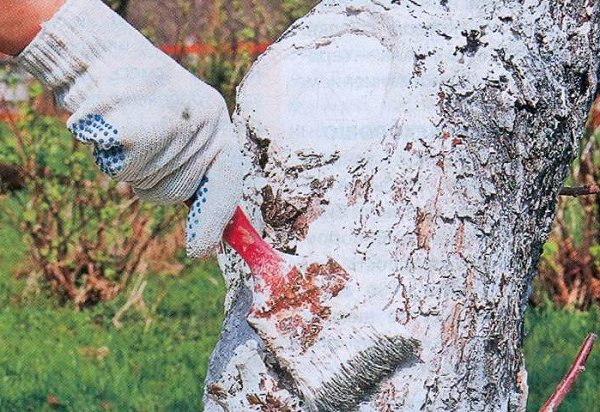

Bark lesions need to be whitened.
The entire damaged surface is applied whitewashing or putty... An effective composition of clay and mullein, which are mixed in equal parts. You can only use clay, which must first be soaked and kneaded properly.
If the mechanical damage is eliminated in time, then the negative consequences can be avoided.
It is always possible to grow a healthy apple tree in your summer cottage, but for this you always need to pay enough attention to caring for it and carrying out at least elementary prophylaxis against pests. If you do not carry it out regularly, then the question of how to treat an apple tree will arise quickly enough. And if you do not start activities on time, then not only can the harvest decrease, but the tree can also die. In the worst cases, the disease spreads to other fruit trees and is capable of infecting almost the entire garden in a short time, causing serious damage to it.
Lichens
Gardeners often confuse lichens on apple tree trunks with diseases. They can range in color from silvery green to gray-black. By themselves lichens do not bring any harm to apple trees, but due to the fact that pests like to hibernate under their cover, it is better to protect trees from risky neighbors.
Remove lichens mechanically, preferably with a scraper, since a metal brush can damage the bark.
They are mostly easy to clean. If it is impossible to remove immediately, produce spraying overgrown with lichen area soapy water and after 20 minutes, peel off without using force.
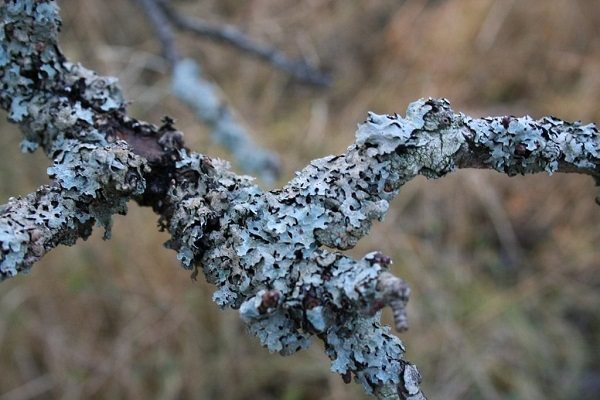

Lichen on the trunk of an apple tree.
If the bark on the apple tree is damaged annularly, to restore sap flow and save the tree, it is necessary to apply inoculation with a "bridge". This method can only be used in early springuntil the tree is fully awake, and the grafting material is harvested before the buds begin to open.
An example scenario:
Important! Our garden is our brainchild that requires constant attention. The more seriously we take his problems, noticing the slightest changes in the development of apple trees, the more abundantly our work will be rewarded.
Diseases of apple trees and their treatment
Diseases, most often affecting the trunks of apple trees, appear in cases where there is no proper care for them: the crown does not form, the stem does not whiten, last year's leaves are not removed. After all, the development of even the most serious disease always starts small.
Lichens
This type of parasite affects weakened trees that are not ventilated due to the dense crown, have frozen wood areas, cracked bark and survived the harsh winter. Lichen has different shades, from yellowish to whitish. It can be bushy, scaly or lamellar, since it always consists of a symbiosis of fungi and algae. It begins to grow along the trunk with the arrival of heat, and sucks moisture directly from the apple tree, causing irreparable damage to it.Reproduction occurs very quickly, since fungal spores are spread even at the slightest breath of wind, so if there are other varieties and types of fruit near the apple tree, treatment should be started immediately. Or, when this is not possible, you need to isolate the affected area from the wind at least for a short period of time by wrapping it with foil.
How to treat damaged apple bark
The top cover of the tree protects the wood from the effects of many factors, so the bark must also be given due attention. By the fall, it begins to die off and peel off, so it must be cleaned off in a timely manner, and the trunk must be whitewashed with lime to prevent the multiplication of lichens and other fungal diseases. In addition to lime, there are other whitewash compositions that are no less effective.
Treatment of wounds that appear on the bark should be carried out in the spring, since before the start of sap flow, they must be overgrown, otherwise the apple tree will be weakened. So, frost holes and other areas exposed to cold weather should be immediately treated with special clay or self-prepared garden pitch. A good putty is obtained by adding a mullein to it - this way you can nourish the tree and give it the strength to heal the wound. Do not coat damaged areas with kerosene, oil, tar and mineral oils! Cracks should first be cleaned of old bark, and if they appeared from the weight of snow at the fork of two skeletal branches, then after that you need to pull them off with wire, clamps or staples. After that, you can process the newly converged area with clay, diluted in half with a mullein and wrap it with felt or unnecessary cloth in several layers to prevent infection.
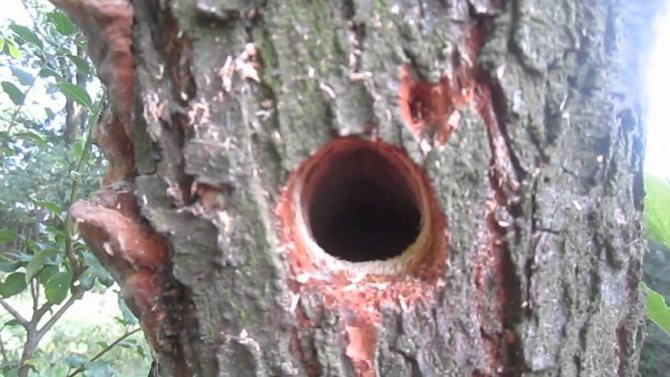

If a hollow has arisen on the apple tree, then initially you need to clean everything inside in order to remove the rotten part of the wood to a healthy one and disinfect it with 5% iron sulfate. After that, you need to prepare a wooden sleeve to size, drive it in carefully so that there are no gaps. The next stage is the treatment of the place with garden putty and painting the trunk with a special oil paint. This method is suitable if a small hollow has appeared in the tree, but large ones are closed up in a slightly different way. So, after cleaning and thorough disinfection, you need to dry everything inside a little, fill it with rubble and cement it. This must be done to stop air and water from entering the hole. You can mix cement with sand - this mix is also very good for embedding. The proportions in this case are 1: 6. In no case do not leave a tree with a hollow unattended, otherwise it will give a small harvest of apples over the next few years, and then it may die or become infected with other serious diseases.
conclusions
Apple tree care in autumn: Harvesting
After the last apples are ripe, you need to remove all the fruits from the branches, even those where it is very difficult to get them. Not a single apple should overwinter on the branches, both scab and moniliosis will overwinter with it.
Preparing apple trees for winter begins with a thorough harvesting under them. To make it efficiently, carefully collect all the carrion and fallen leaves. Many fungi remain in the fallen leaves, and in the spring the pathogens will be carried onto the branches by the wind.
Caterpillars and larvae of harmful insects also feel very comfortable there. The carrion is sorted. Something is suitable for processing or consumption, but not for storage.
Important! It is better to burn the leaves, especially if scab or moniliosis has been noticed. The resulting ash is a good fertilizer.
Pruning
Novice gardeners often ask if these trees are pruned in the fall. If you want to carry out high-quality care of the apple tree in the fall, then the answer is categorical: pruning the apple trees in the fall is necessary! But it's important to know how and when to trim them. After most of the leaves have fallen off, you can start pruning.
Attention! Pruning should not be carried out in rainy weather and in frost more than -10 ° C.
Treatment: help a damaged tree in the garden
Cytosporosis primarily infects weakened plants, usually growing on poor heavy soils. To prevent the development of any fungal diseases, it is necessary to fulfill (do) all the requirements for caring for apple trees: feed (feed), do therapeutic uprooting, watering, but avoid stagnation of moisture and excessive moisture. It is necessary to remove dry and damaged branches and be sure to cover all damage on the bark with garden varnish, even the smallest point on an old or young tree.
Top dressing of apple trees in autumn
Autumn feeding of apple trees, and all other fruit trees, is good to combine with watering. Then the fertilizer will reach the roots much faster. Fertilize apple trees in the fall with potassium and phosphorus. 1 tbsp potassium sulfate and 2 tbsp. double superphosphate is stirred in 10 liters of water. If the trees are younger than 10 years old, then 1 bucket per square meter will be enough. For older trees, you need twice as much.
Important! When feeding apple trees in autumn, nitrogen fertilizers are unacceptable! They will cause shoot growth and weaken the tree. You can even destroy a tree with such fertilizer.
How to treat pests and diseases: Stripping the bark
Preparing apple trees for winter in the fall requires attention to the bark. Many pests and pathogens overwinter under old bark, in cracks. Cleaning the bark will help keep your garden healthy.
Interesting on the topic: Why apples rot right on the tree, and what to do: Fruit rot - Moniliosis
Examine the bark carefully. The lagging one should be removed, pests must have settled under it for the winter.To make your apple tree care complete in the fall, do not be lazy, inspect the branches. Aphids lay eggs near the buds. They look like small black dots. They are carefully scraped off. At the bottom of the trunk, you can see the masonry of caterpillars or their pupae, resembling felt. Be sure to remove them.
☝ After stripping the bark, the entire trunk is treated with a 3% solution of ferrous sulfate (300 g per bucket of water). You can take copper sulfate in the same concentration.
If the fruits were badly damaged by scab or fungal rot, then good results will be obtained by treating apple trees in the fall from diseases and pests with a solution of urea at the rate of 0.5 kg per 10 liters of water. Although it is a nitrogen fertilizer, it will not bring harm if the treatment is carried out 2 weeks before stable frosts after the end of the leaf fall.
Fungal diseases of the fetus
In practice, from fungal diseases on apples is most often manifested scab... Its spots can still be observed on the tree during the ripening of apples.
The second most common disease that affects the fruits of the apple tree is moniliosis (fruit rot).
At first, the disease does not manifest itself in any way. During storage, concentric spots of fungus appear on the apples, the fruit turns black and rots. The worst part is that it infects neighboring apples.
All other diseases lead to a complete loss of crops:
Important! To keep apples less damaged when harvesting for storage, work with gardening gloves. The slightest scratch on the apple causes an avalanche-like process in the storage, all the removed fruits are at risk.
Preparing apple trees for winter: Autumn whitewashing
It is not uncommon to see gardeners whitewash the trunks in the spring. In addition to aesthetic pleasure, such whitewashing does not give anything, because its main purpose —
save the bark from sunburn and cracking in frosty weather. You need to take care of the apple tree in the fall
.
Another purpose of whitewashing —
protection against pests, therefore, copper sulfate is often added to the whitewash mixture. For 10 liters of water, 2.6 kg of lime, 0.6 kg of vitriol and 250 g of carpentry or casein glue are taken.
Interesting! When preparing young apple trees for winter, lime is partially replaced with chalk, and glue with milk. Whitewashing is carried out in dry weather from the bottom up to the first fork in the branches.
Digging
When the fallen leaves have already been collected, and the trunks are whitewashed, it is time to carry out a thorough digging of the trunk circle. Otherwise, your preparation of apple trees for winter will not be complete. Indeed, it is in the surface layer of the soil that the larvae of all kinds of pests settle down for the winter. And if you leave everything as it is and do not take proper care of the apple tree in the fall, then next season you will have to spend a lot of energy fighting these uninvited “guests”. In order to destroy their cozy shelters for pests, which they have acquired in the ground, it must be dug up.
Advice! Digging depth is no more than 15 cm, so as not to accidentally damage the roots. Outside the crown, you can also dig up a shovel with a bayonet ... ✍
Prophylaxis
To prevent the appearance of a fungal disease, it is necessary to carry out preventive measures:
If you follow simple guidelines, trees will develop properly and grow healthy.
The fungus on the apple tree retains its vital activity for a long time and is able to activate when conditions favorable for it appear. With the appearance of a fungus in a garden culture, the immunity to diseases decreases and, as a result, the yield level becomes lower, and sometimes this leads to the death of trees.
Fighting fungus on an apple tree

